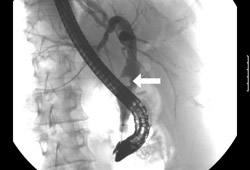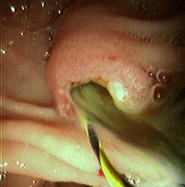Tests
1st tests to order
CBC
Test
Order on admission.
Result
white blood cell count >10,000/microliter (4800-10,800/microliter); platelets decreased
serum BUN
Test
Order on admission.
Result
elevated in patients with severe disease
serum creatinine
Test
Order on admission.
Result
elevated in patients with severe disease
blood gas analysis
Test
Order on admission if sepsis is suspected. In practice, if hypoxemia is not a concern, a venous blood gas (VBG) sample is generally obtained instead of an arterial blood gas (ABG). Evidence shows that a VBG can reliably detect metabolic disturbances compared with an ABG.[36] A VBG is also easier to obtain, less painful for the patient, and associated with fewer complications (e.g., nerve injury, hematoma, infection) (based on expert opinion).
Result
in severe cases low bicarbonate with an elevated anion gap; metabolic acidosis is common in severe disease, raised lactate is associated with sepsis
serum LFTs
Test
Order on admission.[30]
Result
hyperbilirubinemia, elevated serum transaminases and alkaline phosphatase
CRP
Test
Order on admission.
Result
elevated
serum potassium
Test
Order on admission.
Result
may be decreased
serum magnesium
Test
Order on admission.
Result
may be decreased
blood cultures
Test
Order on admission. Positive blood culture rates among patients with acute cholangitis range from 21% to 71%.[28]
Result
bacteria are usually gram-negative but gram-positive bacteria and anaerobes are also implicated in cholangitis
coagulation panel
Test
Order on admission if sepsis is suspected.
Result
prothrombin time may be elevated with sepsis
transabdominal ultrasound
Test
Order in all patients presenting with right upper quadrant pain and suspected cholangitis.[30][31]
Transabdominal ultrasound is a quick, easy, and inexpensive initial diagnostic imaging modality. Its accuracy for detecting common bile duct (CBD) dilation is >90%, although the diameter of the CBD becomes a less useful parameter in patients who have previously undergone cholecystectomy (as physiologic dilation of the CBD can occur in this setting).
Result
dilated bile duct, common bile duct stones
Tests to consider
endoscopic retrograde cholangiopancreatography (ERCP)
Test
Patients with a history of biliary disease, an indwelling biliary prosthesis, or other predisposing factors should be considered for early ERCP for rapid diagnosis and therapy.
Can assist in the diagnosis of cholangitis by finding stones causing obstruction. Is also therapeutic, as the procedure can be used for biliary stone extraction. [Figure caption and citation for the preceding image starts]: Endoscopic retrograde cholangiopancreatography reveals a large common bile duct (CBD) stone (arrow) in the mid-common bile ductFrom the collection of Douglas G. Adler; used with permission [Citation ends]. [Figure caption and citation for the preceding image starts]: Endoscopic photo of same patient following removal of large common bile duct (CBD) stone; note copious pus draining through the ampullaFrom the collection of Douglas G. Adler; used with permission [Citation ends].
[Figure caption and citation for the preceding image starts]: Endoscopic photo of same patient following removal of large common bile duct (CBD) stone; note copious pus draining through the ampullaFrom the collection of Douglas G. Adler; used with permission [Citation ends].
Result
direct observation of bile duct stone or other obstruction
abdominal CT scan with intravenous contrast
Test
Order if there is high clinical suspicion of cholangitis and ultrasound is negative.[31] This modality is superior to ultrasound for visualizing the distal portion of the common bile duct and for defining the extent of neoplasms. If neoplasm is suspected as the cause of cholangitis, abdominal CT is a better initial imaging choice than transabdominal ultrasound. CT scans are contraindicated in patients with intravenous contrast dye allergy and may be detrimental to those with renal dysfunction.
Result
bile duct dilation with possible etiology of cholangitis such as mass, choledocholithiasis
magnetic resonance cholangiopancreatography (MRCP)
Test
Order if ultrasound and CT are negative and a high clinical suspicion remains for cholangitis.[30][31]
While extremely valuable, virtually all patients with cholangitis will ultimately require biliary decompression, most commonly via endoscopic retrograde cholangiopancreatography (ERCP). MRCP should thus not be viewed as a requisite study in patients with suspected cholangitis, but is often a helpful tool in looking for an etiology and in planning for definitive therapy.
Result
mass impinging on biliary tree, stricture, and/or choledocholithiasis
endoscopic ultrasonography (EUS)
Test
Obtain if there is suspicion of a common bile duct (CBD) stricture or stone that has not been already seen on ultrasound or MRCP.[12][30] EUS can also be used if other imaging modalities are unsuitable for the patient. If EUS is positive for CBD stones, ERCP can often be performed concomitantly. EUS can also facilitate biliary decompression via EUS-biliary drainage, if available.[33][34]
Result
CBD stone(s); ampullary, pancreatic and/or biliary masses
surgical approaches
Test
Perform only when other modalities have failed to identify biliary stone(s)/site(s) of obstruction or are not available, or when those modalities are not available, are not feasible, or are contraindicated.
Procedure allows for biliary stone extraction and stenting for purposes of biliary tree drainage/decompression.
In practice, surgery is rarely required for diagnosis.
Result
visual identification of the obstruction
Use of this content is subject to our disclaimer